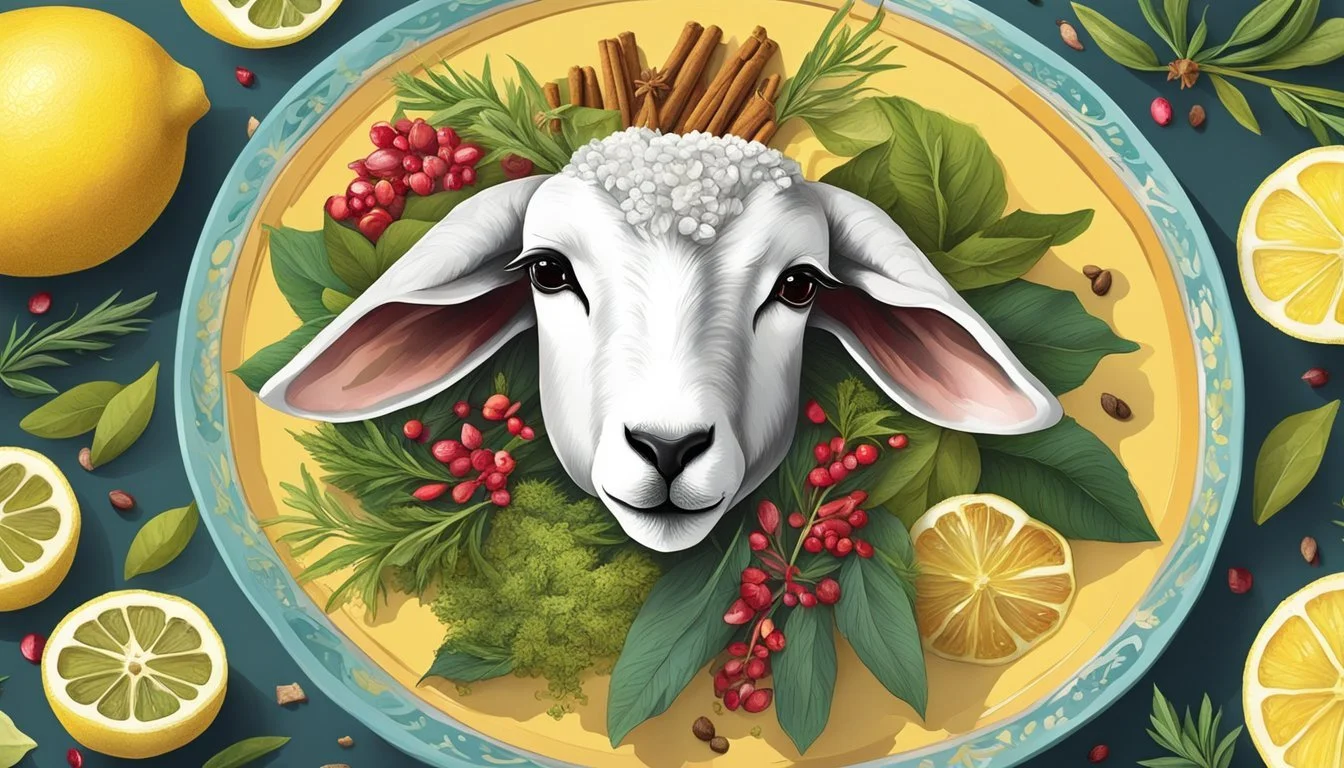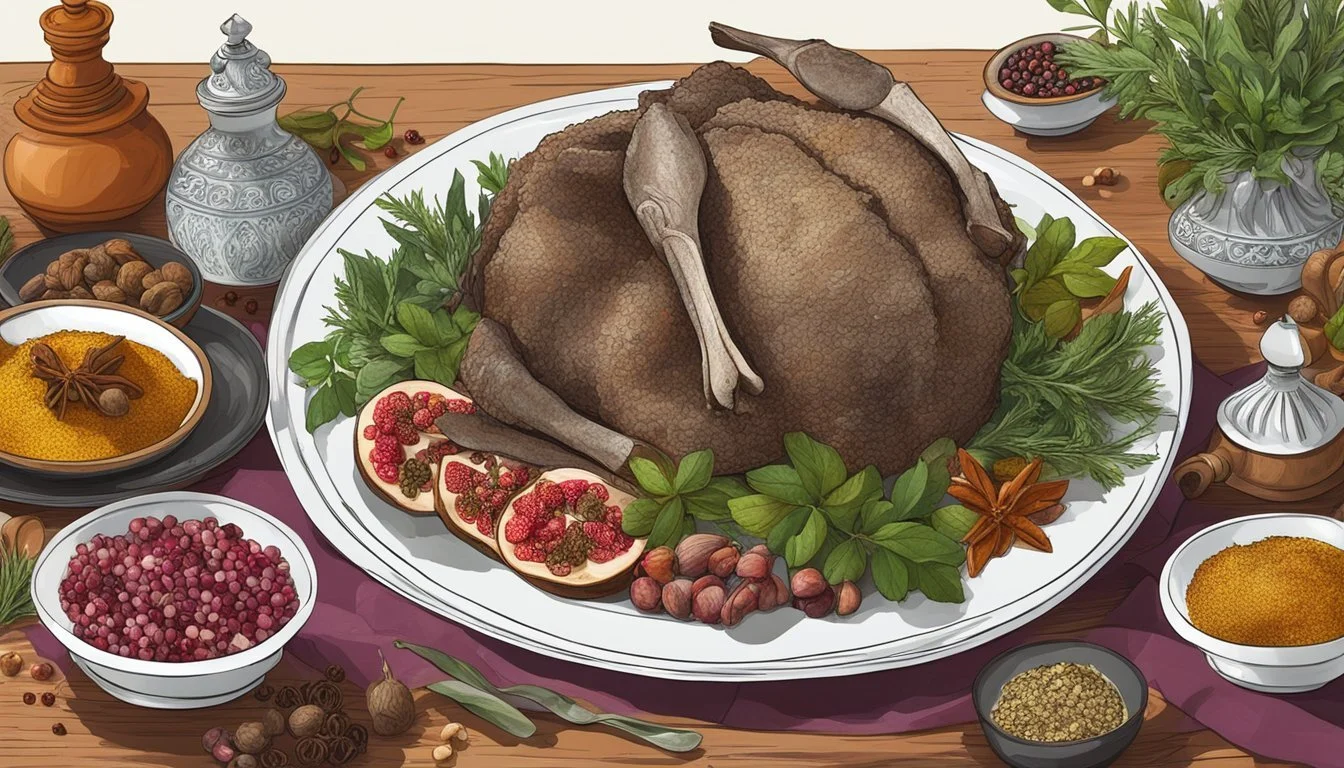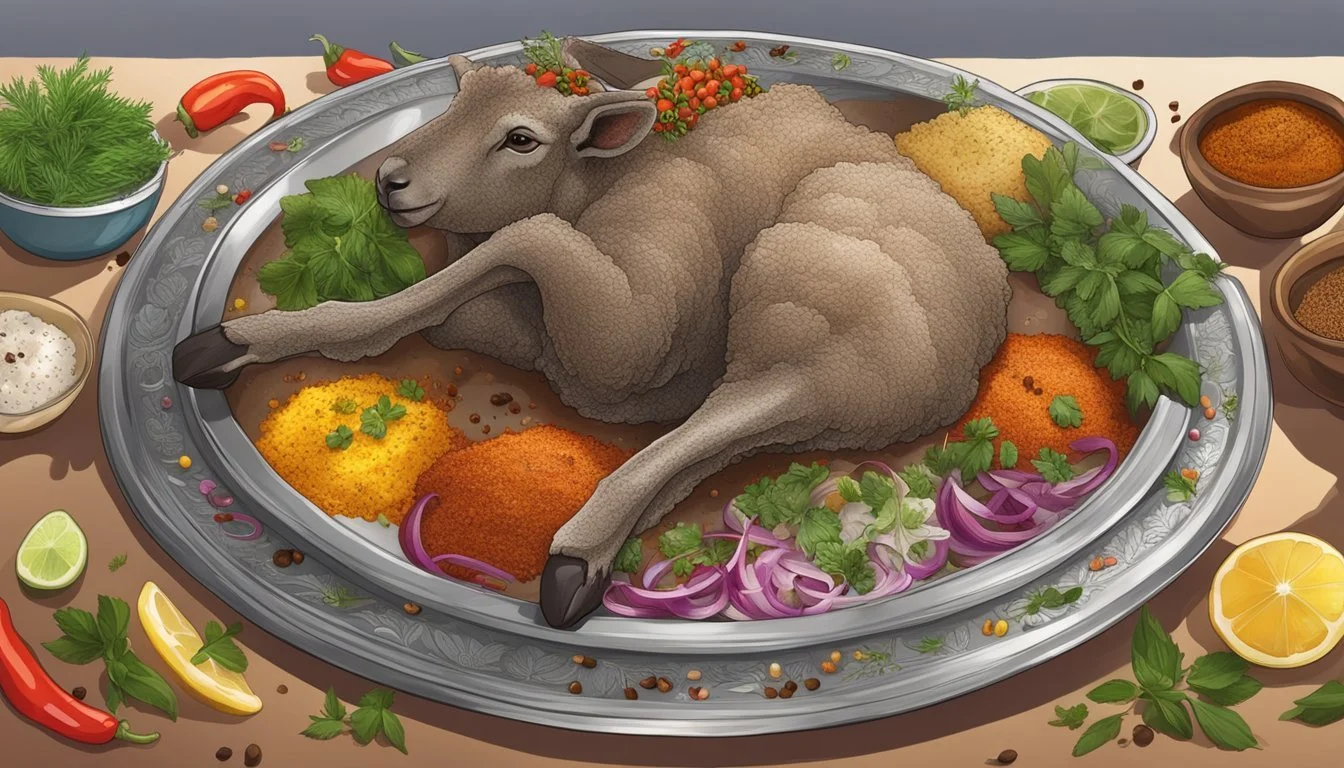Lamb's Head
A Middle Eastern Delicacy Journey to Your Dining Experience
The culinary art of savoring a lamb’s head is a tradition that spans across various cultures, with a particularly strong foothold in the Middle East. Treasured as a delicacy, the lamb's head is prepared with meticulous care to honor its cultural significance and rich flavors. It is served during special occasions and often signifies communal feasting and hospitality, embracing the philosophy that all parts of the animal should be utilized, reflecting respect for the sustenance it provides.
Preparation techniques for lamb's head differ from region to region, with recipes handed down through generations. In the Middle East, the cooking process is devised to ensure that the tender meat is infused with local spices and cooked to perfection, whether it is through boiling, roasting, or slow-cooking. Each method highlights the inherent textures and flavors, balancing the crispiness of the skin against the succulence of the meat beneath.
The presentation of lamb's head as a dish is as important as its preparation, often laid out ceremoniously to celebrate the labor of love that went into its creation. It embodies a rich history of culinary tradition and reflects the pride and identity of the Middle Eastern peoples. Whether served as a centerpiece for festivities or enjoyed as a comfort food, the lamb's head remains a testament to the region's diverse and sophisticated palate.
Historical Significance
The tradition of consuming lamb's head as a meal holds deep historical roots in Middle Eastern culture, transcending mere sustenance to become a symbol of hospitality and celebration. This culinary practice is deeply entwined with regional customs and religious observances.
Cultural Roots
In the Middle East, particularly in countries like Iraq, the preparation and consumption of a sheep's head is more than a culinary preference; it is a practice steeped in history. They have elevated the lamb's head to a ceremonial dish, often served during significant events such as weddings, festivals, and especially religious holidays like Eid al-Adha. This occasion, known as the Festival of Sacrifice, traditionally involves the slaughtering of a sheep, with its head often prepared separately as a sign of respect and honor.
Regional Variations
While the sheep's head is a widespread component of Middle Eastern cuisine, its preparation varies from one region to another, reflecting the diverse culinary landscapes within this area. Iraqi cuisine, for example, is known for its specific techniques and seasonings that distinguish their preparation of the lamb's head. Each locality may have its unique blend of spices or cooking methods, but the underlying tradition of sharing and enjoying a sheep's head meal remains a unifying factor among these cultures.
Nutritional Value
The consumption of lamb's head is not only rooted in cultural traditions but is also considered nutritionally beneficial. Its primary nutrients include a significant amount of protein and various essential vitamins and minerals.
Protein Content
Lamb's head is a rich source of high-quality protein, which is crucial for muscle repair, immune function, and overall body maintenance. On average, 100 grams of lamb meat can contain about 25 grams of protein, which contributes to its substantial protein offering.
Vitamins and Minerals
Lamb provides an array of vitamins and minerals. Notably, it contains vitamin B12, crucial for nerve health and metabolism, and zinc, important for immune function and wound healing. It is also a good source of the minerals iron and phosphorus. A detailed breakdown is as follows:
Vitamin B12: Vital for red blood cell formation.
Zinc: Supports immune function and metabolic rate.
Iron: Key in hemoglobin formation and oxygen transport.
Phosphorus: Important for bone health and maintenance.
Health Benefits
Eating lamb's head can bring health benefits, given its nutrient composition. The protein helps in building and repairing tissues, while the presence of essential vitamins and minerals supports overall health. However, lamb is also a source of saturated fat, and thus it should be consumed in moderation. The calorie count for 100 grams of cooked lamb meat typically ranges around 250-300 calories, with variations depending on the cooking method.
Selecting the Best Ingredients
The success of a dish like lamb's head hinges on the quality of its ingredients. From the freshness of the meat to the harmony of the herbs and spices, each element plays a critical role.
Choosing Quality Lamb
The butcher remains the gatekeeper to quality. For lamb's head, one should seek a butcher known for fresh, ethically-sourced meat. The head should be from a young lamb to ensure tender meat, and its freshness can be discerned by a clean smell and moist, not slimy, texture.
Herbs and Spices
Aromatic seasonings are essential to elevate the lamb's flavor. Fresh herbs like parsley should exhibit a vibrant green hue, signaling their freshness. For spices, one prioritizes well-sourced products that promise potency. Must-haves include:
Garlic: firm, plump bulbs with unbroken skin
Onions: should be firm and free of soft spots
Other Spices: a mix of dried herbs such as thyme and oregano
Accompanying Vegetables
Vegetables act as both a bed for roasting and a component of the dish's flavor profile. Selection tips include:
Carrots: Choose firm, deep orange carrots for their sweetness.
Parsley: Look for bunches with bright, even coloring and crisp leaves.
Incorporating quality ingredients ensures the lamb's head, while perhaps an unconventional cut, is presented at its best, offering a true reflection of the dish's Middle Eastern origins.
Preparation Techniques
Preparing a lamb's head requires specific steps to ensure the delicacy is both safe to eat and palatable. Attention to detail in each phase is crucial, from cleaning and skinning to marinating, and finally, the choice between boiling and roasting.
Cleaning and Skinning
A lamb's head should first be carefully cleaned and skinned. One starts by rinsing the head in cold water to remove any debris. Then, they should skin the head if the skin is not desired in the final dish. For many, the skin is left on as it contributes to the flavor and texture of the roasted head. When the head is to be boiled, they might opt to remove the skin after this process, as it can be more pliable and easier to handle.
Marinating
Marinating the lamb's head is a step that infuses it with additional flavors. They typically prepare a marinade consisting of herbs, spices like cumin and pepper, and sometimes lemon for acidity. The head is coated in this mixture and then refrigerated for several hours, allowing the flavors to penetrate deeply.
Boiling vs. Roasting
Boiling involves submerging the lamb’s head in salted water or a seasoned stock and simmering it for hours until tender. It's a method that ensures the meat is moist and falling off the bone. They may choose to add flavorings like herbs and onions to the liquid to enhance the taste.
Roasting, on the other hand, provides a crispy exterior. The head is first preheated at a high temperature then roasted until the surface is browned and the cheek meat is tender. This technique emphasizes a balance in texture with a succulent interior contrasted by the crisp exterior.
Cooking Methods
Cooking a lamb's head requires specific methods to ensure juicy, tender meat is achieved. Each technique can bring out different textures and flavors from the lamb's head.
Oven Roasting
Using the oven is a widely favored method for preparing lamb's head. This approach encompasses two main steps: initial high-temperature cooking followed by a prolonged period of low heat. Initially, the oven must be preheated to a high temperature; this varies but often hovers around 400°F (200°C). The lamb's head should be seasoned and potentially stuffed with aromatics, depending on the specific recipe or preference. This first phase crisps the exterior, creating a protective barrier. Then, the temperature is reduced to around 200°F (93°C). The lamb's head cooks for an extended period, usually several hours, making the meat fall-off-the-bone tender.
Pressure Cooking
A pressure cooker significantly reduces the cooking time of a lamb's head while still delivering a tender result. With this device, one can cook the lamb's head at a high pressure, which creates an extremely hot and moist environment. It intensifies the flavors and allows tougher proteins to break down more efficiently. The typical cooking duration in a pressure cooker can range from 40 minutes to an hour. It is essential to include a liquid, like broth or water, to create steam and prevent the meat from drying out.
Broiler Options
Using a broiler presents a faster option to achieve a crusty exterior while keeping the interior of the lamb's head moist and juicy. Prior to broiling, a lamb’s head should be seasoned and pre-cooked to ensure even doneness. Broiling is typically done at the end of the cooking process for a short burst of high heat, directly exposing the lamb to intense heat sourced from above. This results in a beautifully seared and flavorful crust. Depending on the broiler's intensity and the distance between the meat and the heat source, the time can vary, so vigilance is essential.
Exploring Lamb Head Recipes
When it comes to preparing a lamb head, chefs and home cooks alike draw upon time-honored techniques and creative modern twists to showcase this unique delicacy.
Traditional Slow Cook
The traditional slow-cooking method is an intrinsic part of Middle Eastern culinary heritage. In this time-honored approach, lamb head is meticulously seasoned with spices like cumin and then nestled into a Dutch oven to be braised with broth, wine, or stock. This low-and-slow technique ensures the meat is tender and flavorsome, with the flesh falling effortlessly away from the bone after several hours of cooking.
- Season lamb head with salt, pepper, and cumin
- Place in Dutch oven with choice of liquid
- Cook on low heat for several hours until tenderModern Interpretations
Chefs around the world have embraced modern culinary techniques, offering innovative interpretations that respect the integrity of the recipe while adding a contemporary flair. Roasting at high temperatures to achieve a balance between a crispy exterior and a succulent interior is one such innovation. Others may marinate the head in a mix of olive oil, herbs, and red wine before baking, incorporating ingredients that reflect the regional palette.
- Marinate lamb head in olive oil, herbs, and wine
- Roast in a preheated oven at high heat for crispy skin
- Baste with the marinade for added flavorSide Dishes
A perfect complement to the rich flavors of lamb head are simple yet elegant side dishes. Couscous (What wine goes well with couscous?), a quintessential grain in Middle Eastern cuisine, often accompanies a lamb head, infused with aromatic spices and herbs. Alternatively, mashed potatoes provide a creamy texture that contrasts delightfully with the meat's complexity. For a lighter option, steamed vegetables offer a healthful balance to the dish, adding color and nutrition to the plate.
- Serve with spiced couscous or creamy mashed potatoes
- Offer steamed vegetables as a lighter accompaniment
- Pair with sauces or dips that complement the lamb's robust flavorServing and Presentation
Serving the lamb's head properly accentuates its unique flavors and textures, thereby ensuring an authentic dining experience. Each step, from carving to garnishing, is done with care to respect the delicacy's cultural significance.
Carving Techniques
The chef must exhibit precision when carving a lamb's head, as it involves separating the tender cheeks and tongue from the bone. They typically use a sharp knife to gently slice the meat, ensuring each cut is clean and avoids waste. It is important to remove the meat skillfully to maintain its succulent texture.
Cheek: Slice parallel to the face, following the bone, until the meat is freed.
Tongue: Carefully detach and slice it crosswise to serve.
Plating
Plating a lamb's head is more than just arranging the meat on a dish; it's an art that requires attention to detail. The carved meat is typically centered on the plate, with the tongue and cheeks arranged in a pattern that is visually appealing. The chef might present the brain separately or incorporate it with the rest of the served meat. The serving plate should be warm to ensure the meat maintains its temperature, providing a better tasting experience.
Arrangement:
Tongue at the center, fanned by slices of cheek.
Brain, if included, served in a small bowl on the side.
Garnishes
Garnishes not only add vibrant color but also enhance the flavors of the lamb's head. A squeeze of fresh lemon juice can brighten up the dish, while a sprinkle of chopped cilantro or parsley adds a refreshing herbal note. These ingredients also serve as a visual complement to the rich colors of the meat, offering an appealing contrast that excites the palate.
Herbs:
Cilantro: Scatter finely chopped over the meat.
Parsley: Use as an alternative to cilantro for a milder flavor.
In presenting the lamb's head, chefs aim for a balance between authentic taste and an elegant visual presentation, ensuring the dish is served as a true Middle Eastern delicacy.
Safety and Sanitation
When dealing with lamb's head as a culinary delicacy, it's crucial to prioritize safety and sanitation to ensure that the food is both enjoyable and safe to consume. Proper storage and avoiding contamination are essential steps in this process.
Proper Storage
Freezer Storage: Lamb's head should be stored in the freezer if not intended for immediate use. It can typically remain frozen for several months without losing quality. It's important to wrap the head properly, preferably in airtight packaging or freezer bags, to prevent freezer burn.
Leftovers: If there are leftovers, they should be refrigerated within two hours of cooking. Leftovers should be consumed within two to three days, and they must be stored in clean, sealed containers to avoid cross-contamination with other foods.
Avoiding Contamination
Cleaning: Before and after handling lamb's head, individuals must thoroughly wash their hands, utensils, and all surfaces to eliminate potential bacteria. Use hot, soapy water to cleanse countertops and cutting boards.
Cross-contamination: Always keep raw lamb's head separate from other foods, especially those that are ready to eat to prevent cross-contamination. This includes using separate utensils and cutting boards for raw and cooked foods.
Pairings and Wine Matching
When bringing lamb's head, a Middle Eastern delicacy, to the table, the right pairings and wine selections are vital for enhancing the dish's rich flavors. This section will delve into the complementary flavors that can accompany lamb's head and guide you through selecting the perfect wine to match.
Complementary Flavors
The flavors that complement lamb's head are ones that can stand up to and balance its distinct taste and texture. Traditional Middle Eastern pairings encompass a variety of herbs and spices, such as cumin, coriander, and mint, to accentuate the lamb’s earthy qualities. These aromatic additions can be incorporated into a salad garnish or mixed within a flavorful broth or stock that braises the lamb's head.
Herbs: Mint, coriander, cumin
Spices: Black pepper, paprika, cardamom
Sides: Rice pilaf; salad with lemon vinaigrette
Selecting the Right Wine
Choosing a wine to accompany lamb's head should aim to both complement and contrast with the richness and particular flavor profile of the dish. Red wines are typically well-suited for lamb due to their ability to interact favorably with the meat's fatty and savory notes.
Medium to full-bodied red wines such as Cabernet Sauvignon and Bordeaux blends pair splendidly with the dish. These wines can offer a robust structure and tannins, which are adept at cutting through the richness of the lamb.
Red wines with notes of dark fruit, moderate acidity, and spice, such as a Syrah or a Chianti, also enhance the succulent flavors of lamb's head without overpowering it.
A balanced pairing should ensure that neither the wine nor the lamb's head dominates the other, but rather that they complement and elevate the overall dining experience.
Customs and Traditions
Lamb's head is a distinctive delicacy served during significant cultural events in the Middle East, embodying the region's customs and traditions in every aspect from preparation to presentation.
Easter Celebrations
Easter in the Middle East incorporates unique traditions reflecting the region's deep historical and religious roots. Lamb's head is notably featured in festive meals, symbolizing sacrifice and rebirth. The consumption of lamb during these times is not only a culinary preference but also a ritual steeped in centuries-old customs.
Feast Preparations
The preparation of lamb's head for feasts is an elaborate process that starts with meticulous cleaning and seasoning. Aromatic spices are used to marinate the meat, which is then slow-cooked to achieve tenderness. This method ensures the meat falls off the bone, creating a memorable dish that honors the traditional cooking techniques passed down through generations.
Cleaning: Thorough and careful, to ensure the meat is palatable.
Seasoning: A blend of regional spices for authentic flavor.
Cooking: Long, slow roasting to enhance taste and texture.
Guest Etiquette
When lamb's head is served, there are specific etiquette norms guests are expected to follow. These practices showcase respect for the host and acknowledge the significance of the meal. Guests typically receive portions of the delicacy in a communal setting, signifying unity and sharing, which are central tenets of Middle Eastern hospitality.
Respect: Acknowledging the effort that goes into the meal.
Unity: Sharing the meal to foster a sense of community.







